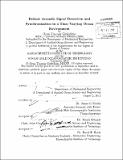| dc.contributor.advisor | James C. Preisig. | en_US |
| dc.contributor.author | Gieleghem, Ryan Thomas | en_US |
| dc.contributor.other | Woods Hole Oceanographic Institution. | en_US |
| dc.date.accessioned | 2013-03-28T18:12:27Z | |
| dc.date.available | 2013-03-28T18:12:27Z | |
| dc.date.copyright | 2012 | en_US |
| dc.date.issued | 2012 | en_US |
| dc.identifier.uri | http://hdl.handle.net/1721.1/78186 | |
| dc.description | Thesis (S.M.)--Joint Program in Applied Ocean Science and Engineering (Massachusetts Institute of Technology, Dept. of Mechanical Engineering; and the Woods Hole Oceanographic Institution), 2012. | en_US |
| dc.description | Cataloged from PDF version of thesis. | en_US |
| dc.description | Includes bibliographical references (p. 99-100). | en_US |
| dc.description.abstract | Signal detection and synchronization in the time varying ocean environment is a difficult endeavor. The current common methods include using a linear frequency modulated chirped pulse or maximal length sequence as a detection pulse, then match filtering to that signal. In higher signal to noise ratio (SNR) environments (- 0 dB and higher) this has been a suitable solution. As the SNR drops lower however, this solution no longer provides an acceptable probability of detection for a given tolerable probability of false alarm. The issue derives from the inherent coherence issues in the ocean environment which limit the useful matched filter length. This thesis proposes an alternative method of detection based on a recursive least squares linearly adaptive equalizer which we term the Adaptive Linear Equalizer Detector (ALED). This detectors performance has demonstrated reliable probability of detection with minimal interfering false alarms with SNR as low as -20 dB. Additionally this thesis puts forth a computationally feasible method for implementing the detector. | en_US |
| dc.description.statementofresponsibility | by Ryan Thomas Gieleghem. | en_US |
| dc.format.extent | 100 p. | en_US |
| dc.language.iso | eng | en_US |
| dc.publisher | Massachusetts Institute of Technology | en_US |
| dc.rights | M.I.T. theses are protected by
copyright. They may be viewed from this source for any purpose, but
reproduction or distribution in any format is prohibited without written
permission. See provided URL for inquiries about permission. | en_US |
| dc.rights.uri | http://dspace.mit.edu/handle/1721.1/7582 | en_US |
| dc.subject | Joint Program in Applied Ocean Science and Engineering. | en_US |
| dc.subject | Mechanical Engineering. | en_US |
| dc.subject | Woods Hole Oceanographic Institution. | en_US |
| dc.subject.lcsh | Signal detection | en_US |
| dc.subject.lcsh | Underwater acoustics | en_US |
| dc.title | Robust acoustic signal detection and synchronization in a time varying ocean environment | en_US |
| dc.type | Thesis | en_US |
| dc.description.degree | S.M. | en_US |
| dc.contributor.department | Joint Program in Applied Ocean Physics and Engineering | en_US |
| dc.contributor.department | Woods Hole Oceanographic Institution | en_US |
| dc.contributor.department | Massachusetts Institute of Technology. Department of Mechanical Engineering | |
| dc.identifier.oclc | 829830690 | en_US |
